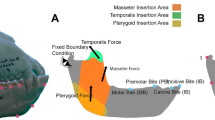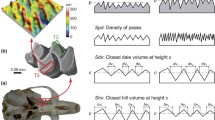Abstract
No matter how a primate acquires its food and what sorts of things it eats, mastication is an important step in food processing. According to Crompton and Hiiemae (1969), Hiiemae (1978, this volume), Hiiemae and Kay (1973), Kay and Hiiemae (1974), Beyron (1964) and Ahlgren (1966), chewing is done in all primates (so far investigated) in largely the same fashion. In a cyclic movement, the mandible is lowered (opening stroke), adducted (closing stroke), and finally moved in the power stroke upwards and inwards with the lower teeth exerting compressive and shearing forces on the food particles pressed against the upper teeth. This is done on one side only, called the biting side.
Access this chapter
Tax calculation will be finalised at checkout
Purchases are for personal use only
Preview
Unable to display preview. Download preview PDF.
Similar content being viewed by others
References
Ahlgren, J. (1966) Mechanisms of mastication. Acta odont. scand. 24, suppl. 44: 1–10.
Beyron, H. (1964) Occlusal relations and mastication in Australian aborigines. Acta odont. scand. 22: 597–678.
Crompton, A.W. and Hiiemae, K.M. (1969) How mammalian molar teeth work. Discover 5: 23–34.
Gingerich, P.D. (1971) Functional significance of mandibular translation in vertebrate jaw mechanics. Postilla 152: 3–10.
Hansmann, W. (1978) GRAFEIN. Ein Program zur dialogunterstützten Erfassung allgemeiner graphischer Informationen. IKPBericht 1/78, Bochum.
Hiiemae, K.M. (1978) Mammalian mastication: a review of the activity of the jaw muscles and the movements they produce in chewing. In “Development, Function and Evolution of Teeth” ( P.M. Butler and K.A. Joysey, eds.), pp. 359–398. Academic Press, London.
Hiiemae, K.M. and Kay, R.F. (1973) Evolutionary trends in the dynamics of primate mastication. In “Craniofacial Biology of Primates” (M. Zingeser, ed.), pp. 28–64. Symp. 4th Int. Cong. Primat., Karger, Basel.
Hylander, W.L. (1979a) Mandibular function in GaZago crassicaudatus and Macaca fascicularis: An in vivo approach to stress analysis of the mandible. J. Morph. 159: 253–296.
Hylander, W.L. (1979b) The functional significance of primate mandibular form. J. Morph. 160: 223–240.
Kay, R.F. and Hiiemae, K.M. (1974) Jaw movement and tooth use in recent fossil primates. Am. J. phys. Anthrop. 40: 227–256.
Kummer, B. (1959a) Bauprinzipien des Saugerskeletes. Thieme-Verlag, Stuttgart.
Kummer, B. (1959b) Biomechanik des Säugerskelets. In “Handbuch der Zoologie (J-G. Helmcke, H.V. Lengerken and D. Starck, eds.), vol. 8, pt. 24, pp. 1–80. De Gruyter, Berlin.
Kummer, B. (1972) Biomechanics of bone: Mechanical properties, functional structure, functional adaptation. In “Bio-mechanics–Its Foundation and Objectives” ( Fung, Perrone and Anlicker, eds.), pp. 237–271. Prentice Hall, Englewood Cliffs, N.Y.
Maier, W. (in press) The functional morphology of the gibbon dentition. In “The Lesser Apes: Evolutionary and Behavioural Biology” (D.J. Chivers, H. Preuschoft, N. Creel and W. Brockelman, eds.). Edinburgh University Press.
Maier, W. and Schneck, G. (1981) Konstruktionsmorphologische Untersuchungen am Gebiss der hominoiden Primaten. Z. Morph. Anthrop. 72: 127–169.
Pauwels, F. (1965) Gesammelte Abhandlungen zur funktionellen Anatomie des Bewegungsapparates. Springer-Verlag, Berlin.
Preuschoft, H. (1969) Statische Untersuchungen am Fuss der Primaten. I: Phalangen und Metatarsalia. Z. Anat. Entw.Gesch. 129: 285–345.
Preuschoft, H. (1970) Functional anatomy of the lower extremity. In “The Chimpanzee” ( G.H. Bourne, ed.), vol. 3, pp. 221–294. Karger-Verlag, Basel, München, New York.
Preuschoft, H. (1971a) Body posture and mode of locomotion in early Pleistocene hominids. Folia primatot. 14: 209–240.
Preuschoft, H. (1971b) Mode of locomotion in subfossil giant lemurids from Madagascar. In “Proc. 3rd int. Congr. Primat., Zürich, 1970”, vol. 1, pp. 79–90. Karger-Verlag, Basel, New York.
Preuschoft, H. (1973a) Functional anatomy of the upper extremity. In “The Chimpanzee” ( G.H. Bourne, ed.), vol. 6, pp. 34–120. Karger-Verlag, Basel, München, New York.
Preuschoft, H. (1973b) Body posture and locomotion in some East African miocene Dryopithecinae. In “Human Evolution” ( M.H. Day, ed.), vol. 11, pp. 13–46. Taylor and Francis, London.
Preuschoft, H. (1979) Motor behavior and shape of the locomotor apparatus. In “Environment, Behavior and Morphology: Dynamic Interactions in Primates” ( Morbeck, Preuschoft and Gomberg, eds.), pp. 263–275. G. Fischer, New York.
Preuschoft, H., Reif, W.E. and Müller, W.H. (1974) Funktionsanpassungen in Form und Struktur an Haifischzähnen. Z. Anat. Entw.-Gesch. 143: 315–344.
Simons, E.L. and Pilbeam, D.R. (1965) Preliminary revision of the Dryopithecinae (Pongidae, Anthropoidea). Folia primatol. 3: 81–152.
Smith, J.R. (1978) Mandibular biomechanics and temporomandibular joint function in primates. Am. J. phys. Anthrop. 49: 341–350.
Tattersall, J. (1973) Cranial anatomy of the Archaeolemurinae (Lemuroidea, Primates). Am. Mus. Nat. Hist. Anthrop. Papers 52: 1–110.
Author information
Authors and Affiliations
Editor information
Editors and Affiliations
Rights and permissions
Copyright information
© 1984 Springer Science+Business Media New York
About this chapter
Cite this chapter
Demes, B., Preuschoft, H., Wolff, J.E.A. (1984). Stress-Strength Relationships in the Mandibles of Hominoids. In: Chivers, D.J., Wood, B.A., Bilsborough, A. (eds) Food Acquisition and Processing in Primates. Springer, Boston, MA. https://doi.org/10.1007/978-1-4757-5244-1_16
Download citation
DOI: https://doi.org/10.1007/978-1-4757-5244-1_16
Publisher Name: Springer, Boston, MA
Print ISBN: 978-1-4757-5246-5
Online ISBN: 978-1-4757-5244-1
eBook Packages: Springer Book Archive




